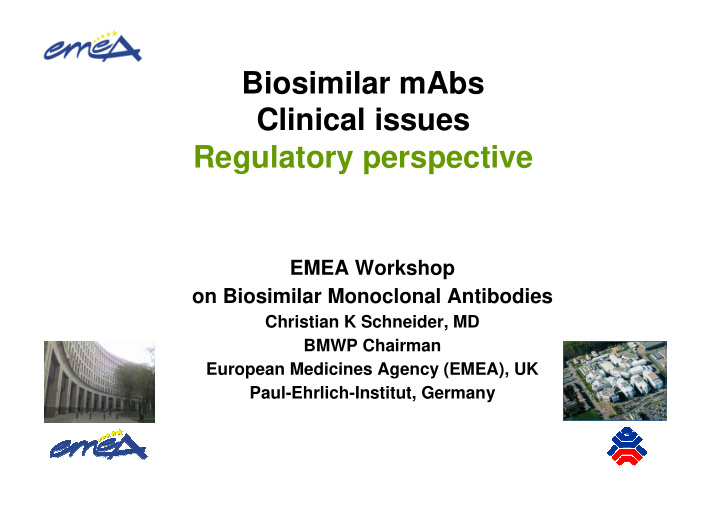



Biosimilar mAbs Clinical issues Regulatory perspective EMEA Workshop on Biosimilar Monoclonal Antibodies Christian K Schneider, MD BMWP Chairman European Medicines Agency (EMEA), UK Paul-Ehrlich-Institut, Germany
Mechanisms of action can be complex! TNF-R1 (CD120a; p55/60) (most tissues; mTNF α and sTNF α ) � Example: TNF α TNF-R2 (CD120b; p75/80) (only immune cells; only mTNF α ) antagonism Differentiation Inflammation Cellular proliferation (TNF-R1 signalling) Tumourigenesis Apoptosis TNF α Viral replication www.wikipedia.org Christian K Schneider 2
Heretic‘s FAQ (not necessarily my view…) � Can the mechanism of action be extracellular intracellular understood as a sole ligand- receptor interaction? (or its inhibition by a mAb?) SIGNALLING mAb � Is it important what comes „after“? � Does the mechanism of action have to be known? Ligand Receptor French illumination, 14th century Christian K Schneider 3 (www.welt.de)
Licensed mAbs: Efficacy and safety � Example anti-TNF α antibodies *) : How to design a biosimilar development programme? � Licensed indications: Therapeutic equivalence? » Rheumatoid arthritis Non-inferiority? » Adult Crohn‘s disease All indications? » Paediatric Crohn‘s disease Extrapolation of efficacy? » Ulcerative colitis Extrapolation of safety?? » Ankylosing spondylitis What endpoints? » Psoriatic arthritis (Activity or Benefit?) » Psoriasis (Phase II or Phase III endpoints?) *) example chosen since well suitable to explain regulatory issues Christian K Schneider 4
Extrapolation of indications � Guideline on Similar Biological Medicinal Products containing Biotechnology-Derived Proteins as Active Substance: Non-Clinical and Clinical Issues: » „In case the originally authorised medicinal product has more than one indication, the efficacy and safety of the medicinal product claimed to be similar has to be justified or, if necessary, demonstrated separately for each of the claimed indications.“ » „In certain cases it may be possible to extrapolate therapeutic similarity shown in one indication to other indications of the reference medicinal product.“ » „Justification will depend on e.g., clinical experience, available literature data, whether or not the same mechanisms of action or the same receptor(s) are involved in all indications.“ » Distribution, density, avidity and other characteristics of these receptors per indication? » „Possible safety issues in different subpopulations should also be addressed.“ Christian K Schneider 5
Mechanisms of action can be complex! TNF-R1 (CD120a; p55/60) (most tissues; mTNF α and sTNF α ) � Example: TNF α TNF-R2 (CD120b; p75/80) (only immune cells; only mTNF α ) antagonism Differentiation Inflammation Cellular proliferation (TNF-R1 signalling) Tumourigenesis Apoptosis TNF α Viral replication www.wikipedia.org Christian K Schneider 6
Spectrum of Uncertainty Primary Structure Can these ever be biosimilar? Post Trans Mod How similar is Higher structure biosimilar? Impurities Can these be bioidentical? Peptides Protein Glycosylated mAbs Blood products ATMP Source: Cecil Nick, Parexel Christian K Schneider 7
Spectrum of Uncertainty Primary Structure Extent of Difference Can these ever be biosimilar? Higher structure Glycosyl- ation Related Impurities Process Surrogate e.p. Impurities Can these be Low variability /short term e.p. bioidentical? High variability /long term e.p. PD Peptides Protein Glycosylated mAbs Blood products ATMPs Acceptable Complexity of Product Endpoints Source: Cecil Nick, Parexel Christian K Schneider 8
Extrapolation � Extrapolation of indications: » What if mechanism of action is poorly understood? (e.g. interferons) » What if clinical endpoints for other indication(s) are not sensitive enough? � Recent „milestones“: » Guideline on biosimilar LMWH ( extrapolation ) » Reflection paper on biosimilar alpha-interferons ( „PD fingerprinting“ ) Christian K Schneider 9
Case-by-case puzzle? Comparative physico-chemical and Comparative physico-chemical and biological characterization biological characterization Bio- Bio- Bio- Combined assay Method 3 assay assay Combined Method 1+2 #3 Method 4 #2 #1 Method 1+2 Potency assay PD PD PD marker marker marker Comparative #1 #2 #3 PK Non-clinical PD Comparative Comparative marker PK toxicity Non-clinical PD PD Comparative PD marker marker toxicity marker #5 #6 Comparative #4 PK Clinical Surrogate endpoint Comparative Marker INDICATION #1 safety PD PD INDICATION #3 Comparative PD Surrogate INDICATION #1 marker marker safety marker Endpoint #7 #8 #9 Surrogate Surrogate Known Marker Marker Class effects INDICATION #4 INDICATION #2 mAb 1 mAb 2 Christian K Schneider 10
Immunogenicity Christian K Schneider 11
Immunogenicity � mAbs are not for substitution of endogeneous proteins like recent biosimilars (EPO, G-CSF,…) � Is the perception of risk different? » Antibodies against mAbs are mostly anti-idiotype (not anti-isotype) » Endogeneous IgG abundant! � Is Immunogenicity the „highest“ safety concern? � …but immunogenicity nevertheless important! Christian K Schneider 12
Practical issues � Acceptability of biosimilar mAbs, e.g. in the oncological setting? (or: To what extent is the „biosimilar“ philosophy known to patients and physicians?) � How to practically deal with phase I PK/PD studies in patients: » Are usually single dose studies » Cross-over? » How to continue treatment? Switch to reference? Christian K Schneider 13
The floor is yours! Christian K Schneider 14
Recommend
More recommend